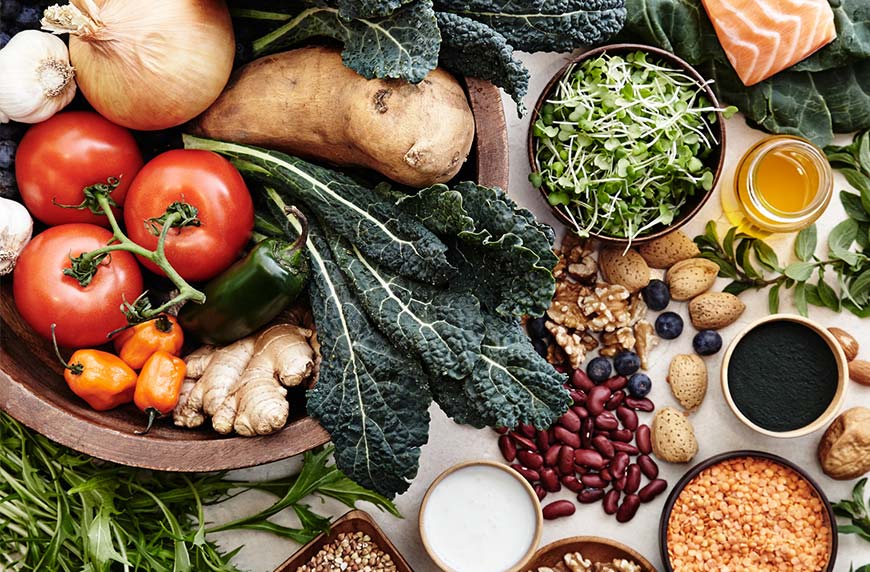Does Where You Live Impact the Type of Diet You Should Follow?
The traditional American diet isn't exactly the go-to model for healthy eating. It seems like everyone else is eating healthier than Americans—from Asian-influenced meals (naturally high in veggies and low in dairy) and diets inspired by Blue Zones (the places in the world where people live the longest) to the heart-healthy Mediterranean Diet, and even French cuisine. But there's a question never asked when each of these eating plans is held up as The One to live by: Do they work when you don't live in the region where they originated?
Studies have shown that environment impacts the microbiome. What exactly does this mean for the type of food that keeps the gut perfectly balanced? Does an Asian-influenced diet work best for microbiomes acclimated to the East? Or will someone living in Middle America reap the same benefits, geography aside?
Here, a gastroenterologist weighs in to set the record straight, giving science-backed advice on how to choose a diet that is truly best for your body.
Does where you live affect the type of diet you should follow? Scroll down to find out.

How environment and culture affects the gut
Where you live affects the bacteria in your gut—science says so. In one study, researchers compared the bacteria of surfers to non-surfers and found that the ocean is literally changing surfers' microbiomes. In another study, researchers compared the microbiomes of children and adults living in Malawi, the United States, and remote villages in South America and found distinct differences.

{{post.sponsorText}}
Rabia De Latour, MD, a gastroenterologist at New York University Langone Health, points out that environment and culture has an affect on the gut. "Microbiomes differ from one another for a variety of reasons, including not just the foods you eat but where you grow up and the amount of antibiotics you get," she says. "In America, we get antibiotics all the time—we probably overuse them. But in England, for example, nowadays it's exceedingly hard to get prescribed antibiotics because of the knowledge of how much it impacts the gut." Even if you were delivered naturally or by C-section plays a role in what your microbiome looks like.
Of course, what you eat as you grow up plays a role, too. If you grow up eating processed food, your microbiome is going to look drastically different from someone who eats kimchi every single day and has never had a sip of soda. And this holds true whether you're chomping on fermented foods east or west of the Pacific.

How to choose an eating plan that does your body good
When it comes to figuring out what to eat—regardless of where you live—Dr. Latour's biggest piece of advice is to choose an eating plan that science has shown is beneficial. "Some diets are fads, but certain ones are linked to better health outcomes, like the Mediterranean Diet," she says.
"It's straightforward and it make sense," Dr. Latour says of why she likes this eating plan in particular. "It focuses on fruits and vegetables, whole grains, protein, and healthy fats. It doesn't matter what new diet starts trending or what best-selling diet book is out, [medical professionals] always come back to these recommendations."
As a gastroenterologist, Dr. Latour knows one major reason you might want to seek out a new eating plan is because of annoying digestive issues. In those cases, her best recommendation is to try the low-FODMAP diet—an eating plan low in fructose, lactose, and galactans—to really pinpoint what's upsetting your stomach.
Switching up your eating plan doesn't always make your symptoms better. And even if it does, Dr. Latour says it typically takes the gut about two weeks to adapt, so she tells her clients to wait a full month to see if a new eating plan is working.
Since every body is different, there isn't one strict eating plan that will work for everyone—no matter where you live. But Dr. Latour emphasizes that whatever cultural cuisine you favor—whether that's Mexican, Japanese, Danish, or something else entirely—eating a variety of foods and filling your plate with fruits, veggies, whole grains, protein, and healthy fats is the key. And that advice translates to every language.
Speaking of diets, here's a whole A to Z glossary of the most popular eating plans. Plus, how to make healthy foods even healthier.
Loading More Posts...